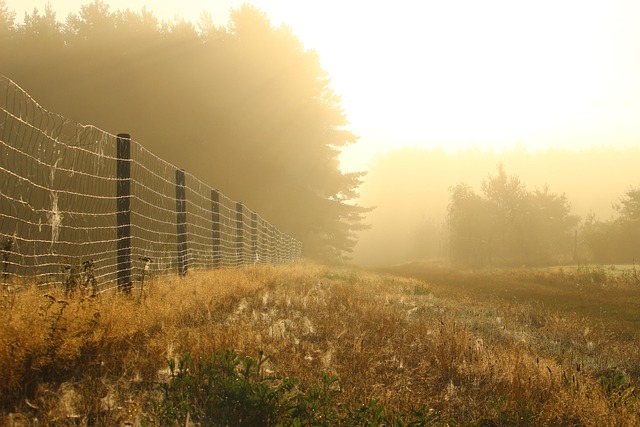In the heart of New Bedford, MA, ornamental fencing stands as a testament to the city’s rich history and evolving aesthetic. This article delves into the diverse landscape of fencing styles that have adorned New Bedford over the years, from traditional Victorian designs to contemporary minimalist looks. We explore popular choices, the materials shaping local landscapes, and the multifaceted benefits these fences bring. Additionally, practical installation tips ensure long-lasting beauty and functionality.
- Historical Overview of Fencing in New Bedford
- Popular Ornamental Fencing Styles
- Traditional vs Contemporary Designs
- Materials Used in Local Fencing
- Benefits and Applications of Ornamental Fencing
- Installation Tips for Long-Lasting Fences
Historical Overview of Fencing in New Bedford
New Bedford, Massachusetts, like many American cities, has a rich history when it comes to fencing. Historically, fences served practical purposes such as defining property lines and keeping livestock contained. However, over time, functional fencing evolved into an art form, with various styles becoming popular throughout different eras.
The 19th century, in particular, saw the rise of ornate iron fence designs that reflected the industrial aesthetic of the time. These intricate patterns, often featuring floral motifs and curlicues, added a touch of elegance to New Bedford’s landscape. Today, many historical homes and neighborhoods still boast these vintage fences, preserving a visual link to the city’s past while also enhancing modern properties with timeless beauty.
Popular Ornamental Fencing Styles
New Bedford, MA, boasts a diverse range of ornamental fencing styles, each offering unique aesthetics and functional benefits. Among the most popular choices are iron fence designs, characterized by intricate patterns and elegant curves. These fences not only enhance the curb appeal of residences but also provide robust security. The traditional style often features intricate lattices and scrollwork, creating a visually captivating effect that has stood the test of time.
Another favored option is wood fencing, which comes in various forms, from rustic picket fences to more formal vertical boards. Wood offers warmth and charm while being relatively low-maintenance. Modern tastes lean towards minimal, clean lines, often seen in aluminum or vinyl fences. These materials are durable and require little upkeep, making them ideal for busy homeowners. Each style adapts to different property types and personal preferences, ensuring New Bedford’s residential landscape remains as diverse and picturesque as ever.
Traditional vs Contemporary Designs
In New Bedford, MA, when considering ornamental fencing styles, homeowners often find themselves drawn to either traditional or contemporary designs. Traditional fences tend to embody classic aesthetics, featuring intricate patterns and detailed craftsmanship that hark back to older times. These styles often incorporate natural materials like wood, offering a warm, inviting ambiance while also providing privacy and security. By contrast, contemporary fences lean into modern design principles, focusing on clean lines, minimalist aesthetics, and innovative materials such as metal or vinyl. They prioritize functionality and low maintenance, seamlessly integrating with today’s architectural trends.
The choice between traditional and contemporary designs ultimately boils down to personal preference and the desired atmosphere for one’s property. Traditional styles can lend a sense of timeless elegance, while contemporary options offer a fresh, dynamic look that keeps up with evolving fashion. In New Bedford, where historical charm meets modern living, both types of ornamental fencing styles find their place, allowing homeowners to express their unique tastes and enhance the beauty of their homes.
Materials Used in Local Fencing
In New Bedford, MA, the materials used in ornamental fencing reflect a balance between aesthetic appeal and durability. Wood remains a popular choice due to its natural beauty and versatility, with local artisans often employing cedar and spruce varieties for their resistance to rot and insects. These woods are known for their warm tones and can be stained or painted to match any design theme.
Metal is another prominent material, particularly in modern designs. Aluminum and steel fences offer a sleek, low-maintenance option that can withstand harsh weather conditions. Local manufacturers often incorporate decorative elements like swirls, patterns, and intricate designs into metal fences, enhancing their visual appeal. Iron and wrought iron are also used for more traditional, ornate styles, adding a touch of elegance to properties across New Bedford.
Benefits and Applications of Ornamental Fencing
Ornamental fencing adds more than just aesthetic appeal; it provides a range of practical benefits, especially in urban settings like New Bedford, MA. These fences can enhance security by defining property boundaries clearly and deterring unauthorized access while allowing for natural light and air circulation between spaces. In dense neighborhoods, ornamental fences contribute to privacy without completely blocking views, fostering a sense of community and open-ness at the same time.
The versatility of these fencing styles allows them to be incorporated into various settings, from residential properties to commercial landscapes. They can enhance curb appeal for homes, provide visual interest in urban parks, or delineate specific areas within larger grounds like school campuses or business complexes. Ornamental fences are not just decorative; they serve as functional and stylish solutions that cater to both practical needs and aesthetic preferences.
Installation Tips for Long-Lasting Fences
When installing a fence in New Bedford, MA, proper preparation and techniques are key to ensuring longevity. One essential tip is to assess your site and choose a fence style suitable for your property’s conditions. Consider factors like terrain, weather patterns, and proximity to trees or other structures. For instance, a wooden fence might be ideal for level ground but may struggle against harsh winds or overhanging branches.
Before beginning installation, prepare the ground by removing any debris or plants. Dig post holes that are deep enough to support the fence’s weight, especially in areas with high water tables or heavy snowfall. Use proper fencing materials and secure them tightly to posts using galvanised hardware to prevent rusting. Regular maintenance like cleaning, sealing, and painting will also contribute to a fence’s durability, keeping it looking fresh for years to come.
